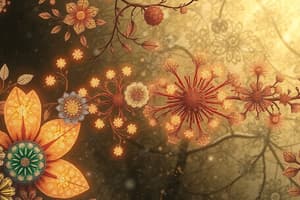Podcast
Questions and Answers
Which of the following is the primary function of the electron transport chain in aerobic respiration?
Which of the following is the primary function of the electron transport chain in aerobic respiration?
- To produce NADH and FADH2 for the Krebs cycle
- To generate a proton gradient that drives ATP synthase
- To oxidize organic molecules and release energy
- To reduce oxygen to water as the terminal electron acceptor (correct)
In anaerobic respiration, which of the following molecules can act as the terminal electron acceptor instead of oxygen?
In anaerobic respiration, which of the following molecules can act as the terminal electron acceptor instead of oxygen?
- Nitrate, iron, or sulfate (correct)
- Glucose
- Pyruvate
- NADH
Which of the following statements about the Krebs cycle is correct?
Which of the following statements about the Krebs cycle is correct?
- It produces NADH and FADH2 but not ATP
- It is the final step in the breakdown of glucose
- It is a part of anaerobic respiration
- It occurs in the mitochondrial matrix and is a crucial part of aerobic respiration (correct)
What is the primary difference between aerobic and anaerobic respiration in terms of ATP production?
What is the primary difference between aerobic and anaerobic respiration in terms of ATP production?
Which of the following is the primary purpose of the FADH2 produced during the Krebs cycle?
Which of the following is the primary purpose of the FADH2 produced during the Krebs cycle?
In anaerobic respiration, what is the primary purpose of the terminal electron acceptor?
In anaerobic respiration, what is the primary purpose of the terminal electron acceptor?
What is the total theoretical ATP yield from one glucose molecule in aerobic respiration for a prokaryotic cell?
What is the total theoretical ATP yield from one glucose molecule in aerobic respiration for a prokaryotic cell?
How many ATP molecules are generated for each FADH2 molecule in aerobic respiration?
How many ATP molecules are generated for each FADH2 molecule in aerobic respiration?
Where does the Krebs Cycle occur in a eukaryotic cell?
Where does the Krebs Cycle occur in a eukaryotic cell?
During aerobic respiration, what is the alternative final electron acceptor if oxygen is not available?
During aerobic respiration, what is the alternative final electron acceptor if oxygen is not available?
How many NADH molecules are produced from the TCA cycle for one molecule of glucose?
How many NADH molecules are produced from the TCA cycle for one molecule of glucose?
What is the net ATP yield from glycolysis for a prokaryotic cell in aerobic respiration?
What is the net ATP yield from glycolysis for a prokaryotic cell in aerobic respiration?
Which of the following is true about the Krebs cycle (TCA cycle)?
Which of the following is true about the Krebs cycle (TCA cycle)?
What is the primary role of the electron transport chain in aerobic respiration?
What is the primary role of the electron transport chain in aerobic respiration?
During anaerobic respiration, what is the final electron acceptor?
During anaerobic respiration, what is the final electron acceptor?
What is the primary function of FADH2 in aerobic respiration?
What is the primary function of FADH2 in aerobic respiration?
Which of the following statements about ATP production in aerobic respiration is correct?
Which of the following statements about ATP production in aerobic respiration is correct?
What is the primary role of NADH in aerobic respiration?
What is the primary role of NADH in aerobic respiration?
Flashcards are hidden until you start studying




